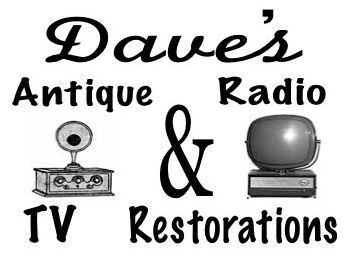 |
Dave's
Antique Radio & TV Restorations |
 |
Dave's
Antique Radio & TV Restorations |
|
|
|
Usually if an
antique radio doesn't play or hums when
you plug it in* and turn it on, it probably needs a new set of
paper and filter capacitors. This is what I define as a restoration. or dave2@dreamscape.com |
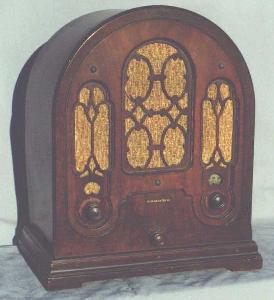
|
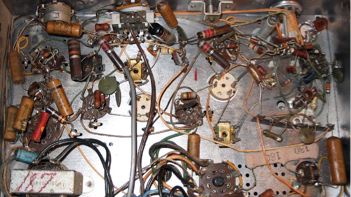 |
When I
receive a radio for restoration I count the number of paper and filter
capacitors and make a note of the values. This is for the estimate. On the left is a view underneath a radio chassis I recently received for a restoration. All the brownish waxy cylinder shaped components are paper capacitors. So is the large black cylinder with stripes on it and so is the cylinder with the blue paper over it. The filter capacitors are in a can, who's pins can be seen at the lower right in a brown disc. This radio contains 14 paper type capacitors that need to be replaced. |
| Paper Type
Capacitors were used in Radios and TVs, from the 1920s
until the 1960s. These were very poorly made. Even at the
time they were in use they could be damaged by moisture. Now we
know that the paper used in the manufacture of those old style
capacitors wasn't acid treated. So over time the acid in the
paper deteriorates the capacitor. This can result in a short circuit or
fire in some cases. So it's not a good idea to turn on an antique
radio before its paper type capacitors are replaced. Paper
was used in capacitors called "paper", "filter" or "electrolytic".
Todays capacitors are made using plastic as the insulator. They don't
suffer from these problems. There are other types of capacitors found in Antique Radios (ceramic disc and mica), which do not have these problems either. So they don't usually need to be replaced. |
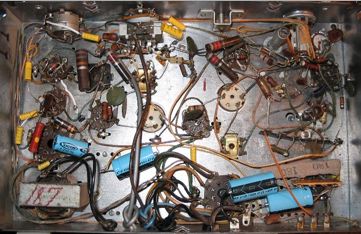 |
| Here is how the same radio looks
restored. All the yellow cylinders are the replacements for the paper
capacitors. The blue cylinders are the replacements for the
electrolytic filter capacitors. There is also a tiny black
cylinder that replaced one of the paper capacitors that was actually a
tubular electrolytic capactor. |
|
|
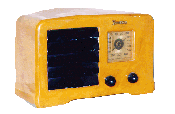 |
To perform the
restoration, I need the chassis and speaker (and wave magnet for
Transoceanics
and other Zenith Radios, or antenna, if any on other radios).
I do not restore cabinets, however I can clean and shine plastic cabinets at no additional labor cost. If your radio cabinet is made out of Catalin, like the radio to the left, please keep your cabinet at home. Catalin is very valuable and very brittle. If this is a radio/phono and you want the changer repaired please send that too. If there is just a tone arm and turntable and no changer, just send the idler and cartridge. I can have them rebuilt. If this is an entertainment center, that includes a Radio/Phono and TV I will consider it as two separate items: a Radio and a TV. |
| Restoration prices vary, however, it has been my experience that if all a set needs is capacitors (which is in most cases): a small set, like a cathedral, with a power transformer if it is in good condition, usually runs under $300.00 + ship to restore. However there are radios with more than 30 paper + filter type capacitors to replace. These sets can cost over $400.00 to restore. A small 5-6 tube AC-DC set with no power transformer usually runs under $100.00 + ship to restore (please see my specials page). If the set needs other parts
besides capacitors, such as resistors, tubes, coils,
transformers, selenium rectifier, etc., the restoration will cost
more,
depending on the price of the additional part(s). Information
about Antique TV
restorations can be found on my Antique TV restoration page.
|
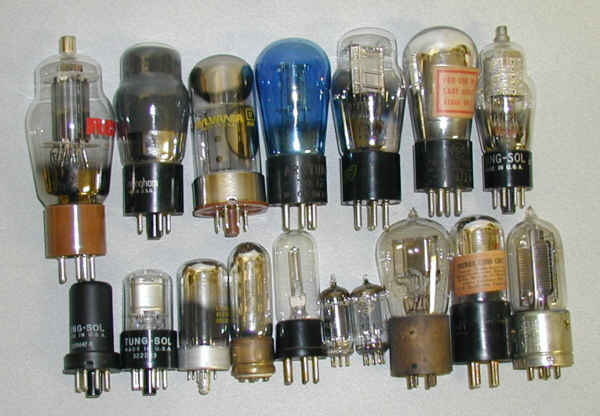 |
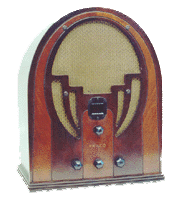 |
Please
package well. Please use
plenty of bubble wrap, plenty of packaging peanuts and a heavy
(double wall) shipping box. Its even better to put a box in a
box with space in between the boxes. I have to use the same packaging to send your antique radio back to you. I cannot continue to buy new cartons and packaging materials for everyone who sends me an antique radio to restore. There are just too many now. So please package well. |
|
All American 5 and 6 Tube Radio Restoration Specials page. |
|
Page
Created: March 1998 on the Borg web site |